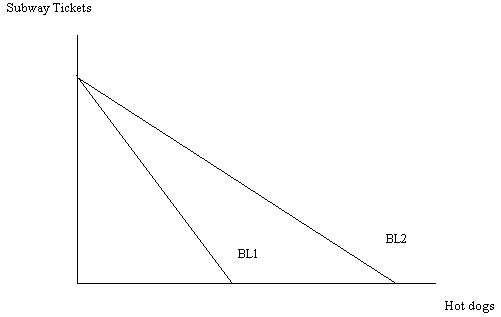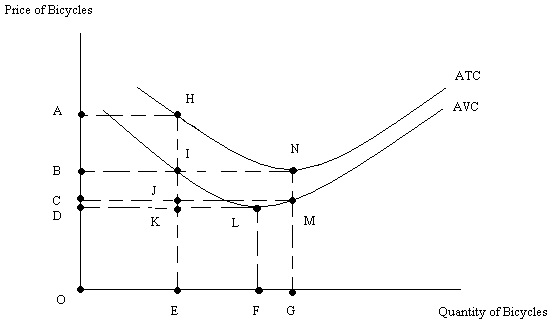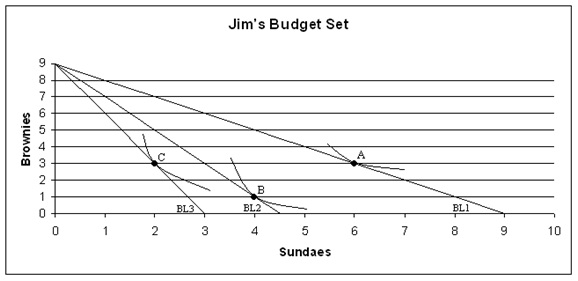I. Binary Choice Questions:
Problem 1. The CPI using 1985 as the base year is equal to 250 for 2006 and 400 for 2007. Suppose we want to use 2007 as the base year. What is the value of the CPI in 2006 using 2007 as the base year?
a. 62.5
b. 160
Problem 2. Suppose Joe’s income doubles and the price of doughnuts and coffee, the two goods Joe purchases with his income, also double. Then
a. Joe will now consume more coffee and doughnuts given his indifference curve map.
b. Joe will not change his current consumption of coffee and doughnuts given his indifference curve map.
Problem 3. Suppose Mary’s income is currently $50 a week and that the price of bus tickets (B) is $2 per ticket and the price of fast food lunches (L) are $2.50 per lunch. If these are the only two goods that Mary buys, then Mary’s budget constraint is
a. B = 25 – 1.25L
b. B = 20 - .4L
Problem 4. Suppose the marginal cost curve is increasing as output increases. Then
a. Average fixed cost must be decreasing.
b. Average variable cost must be decreasing.
Problem 5. Suppose that marginal revenue is greater than marginal cost for a firm. Then to profit maximize this firm should produce a
a. Higher level of output.
b. Lower level of output.
Problem 6. Suppose that the average total cost of producing the fifth unit of output is equal to $6 and the average total cost of producing the sixth unit of output is equal to $5.50. Then the marginal cost of producing the sixth unit is
a. Greater than or equal to $6.
b. Less than or equal to $5.50.
Problem 7. Consider a constant cost perfectly competitive industry. Currently a representative firm finds that in short run equilibrium, its average total cost of production is greater than its marginal revenue. Holding everything else constant, in the long run there will be
a. Entry of new firms into this industry.
b. Exit of firms from this industry.
Problem 8. Suppose a monopolist’s demand curve is linear and can be written as Q = 40 - .8P. Furthermore, suppose the marginal cost for this firm is equal to MC = 5Q + 5. This firm will profit maximize by producing
a. 7.2 units of the good.
b. 6 units of the good.
Problem 9. For a monopoly to exist
a. There must be some kind of effective barrier to entry.
b. The government must have passed a law creating the monopoly.
Problem 10. A market that is characterized as a natural monopoly is one in which
a. A single firm can provide the good at lower average cost than can two or more firms.
b. As output increases the marginal cost curve lies beneath the average cost curve as long as the average cost is decreasing.
II. Multiple Choice Questions:
11. Suppose the CPI in 2006 is equal to 125 and the CPI in 2007 is equal to 150. The nominal price of textbooks increases from 2006 to 2007. Which of the following statements is true?
a. Since the CPI and the nominal price both increased, the real price of textbooks increased between 2006 and 2007.
b. Although the CPI and the nominal price of textbooks increased, it is possible that the real price of textbooks increased, decreased, or remained the same.
c. Since there was inflation in the economy this implies that the real price of textbooks must have risen during this time period.
d. None of the above statements is true.
Problem 12. The nominal wage in 2006 is equal to $30 an hour and the real wage in 2006 is equal to $20 an hour. The CPI in 2006 is equal to 150 and the CPI in 2007 is equal to 300. If the real wage stays constant between 2006 and 2007, what is the nominal wage equal to in 2007?
a. $15 an hour
b. $30 an hour
c. $6 an hour
d. $60 an hour
13. The graph below depicts Mario’s budget line with respect to subway tickets and hot dogs. Assume that Mario only purchases subway tickets and hot dogs and that he does not save any of his income.

Suppose Mario’s initial budget line is BL2 and then his budget line changes to BL1. Furthermore, you know that Mario’s income elasticity of demand for both hot dogs and subway tickets is positive. Which of the following statements must be true given the shift in Mario’s budget line from BL2 to BL1?
a. The price of hot dogs increases and Mario will consume fewer hot dogs.
b. The price of hot dogs increases and Mario will consume fewer hot dogs and fewer subway tickets.
c. The price of hot dogs decreases and Mario will consume fewer hot dogs.
d. The price of hot dogs increases and Mario will consume more hot dogs.
Use the following information to answer the next three questions.
Marissa currently has $100 in income per month that she spends on CDs and books. The current price of a book is $4 and the current price of a CD is $2. With this income, the prices of the two goods and her normal shaped indifference curve map, Marissa chooses to consume 10 books and 30 CDs each month. The local government decides that they would like to encourage reading and so the government enacts a book subsidy that reduces the price of books to $2 while the price of CDs is unaffected. Given these new prices Marissa chooses to consume 25 books and 25 CDs each month. If Marissa’s income was adjusted so that she faced the new prices but was constrained to stay on her original indifference curve she would choose to consume 20 books and 20 CDs a month.
14. What is Marissa’s compensated level of income if her income is adjusted so that she has the same level of utility that she had initially but with the new subsidized prices?
a. $100
b. $180
c. $80
d. $140
15. What is the substitution effect with respect to books for Marissa? The substitution effect is
a. An increase of 10 books
b. An increase of 5 books
c. An increase of 15 books
d. A decrease of 5 books
16. What is the income effect with respect to books for Marissa? The income effect is
a. An increase of 10 books
b. An increase of 5 books
c. An increase of 15 books
d. A decrease of 15 books
Use the following information to answer the next three questions.
You are given the following information about a perfectly competitive constant cost industry comprised of 60 identical firms. The industry demand curve is given by
D: P = 20 – (1/50)Q
where Q is the market quantity demanded. In addition, you know that a representative firm in this industry has a total cost function and a marginal cost function that can be represented by the equations
TC = 25 + 4q + q2
MC = 4 + 2q
where q is the quantity produced by the firm.
Problem 17. At the long run equilibrium the total quantity produced in this market is equal to ________ and the equilibrium price is equal to ________.
a. 1500 units; $10
b. 500 units; $10
c. 300 units; $14
d. 750 units; $5
Problem 18. Suppose that tastes and preferences for this good increase so that at every price in the market the quantity demanded by consumers increases by 400 units. Holding everything else constant, what is the short run equilibrium price and the short run level of production for the representative firm?
a. $14; 7.5 units
b. $14; 5 units
c. $19; 7.5 units
d. $10; 5 units
Problem 19. Given the changes described in question (18) and the initial information, what do you expect will happen in this market to the price and the number of firms in the long run?
a. In the long run the equilibrium market price will increase and the number of firms in the industry will increase.
b. In the long run the equilibrium market price will increase and the number of firms in the industry will decrease.
c. In the long run the equilibrium market price will decrease and the number of firms in the industry will increase.
d. In the long run the equilibrium market price will decrease and the number of firms in the industry will decrease.
Use the graph below to answer the next two questions.
The graph provides information about a firm’s cost curves.

Problem 20. This firm’s fixed cost can be represented as
a. The distance from point M to point N.
b. The distance from point G to point M.
c. The area of rectangle AHIB.
d. The area of rectangle CMGO.
Problem 21. Which of the above statements about the above figure are true?
I. Marginal cost for this firm is equal to OB when the firm produces G units of output.
II. Marginal cost for this firm is equal to LF when the firm produces F units of output.
III. Average fixed cost is constant for this firm.
a. Statements I and II are true.
b. Statements I and III are true.
c. Statements II and III are true.
d. Statements I, II, and III are true.
Answer the next two questions based upon the following information.
You are given the following information about a monopolist. The monopolist’s demand curve for its product can be represented as
Q = 500 – 5P
The monopolist’s marginal cost of production is constant and equal to $20 per unit.
Problem 22. The monopolist will produce _______ units of the good and earn an economic profit equal to __________ in the long run.
a. 200 units; $0
b. 200 units; $1200
c. 200 units; $8000
d. 400 units; $0
Problem 23. The deadweight loss associated with this monopoly is equal to
a. $300
b. $3000
c. $400
d. $4000
Problem 24. Compared to a perfectly competitive industry, a monopoly in the long run
a. Produces a smaller amount of the good and always earns positive economic profit.
b. Produces a smaller amount of the good and may earn a positive or negative economic profit.
c. Produces a smaller amount of the good and may earn a positive or zero economic profit.
d. Produces a smaller amount of the good and may earn a positive, negative or zero economic profit.
Problem 25. Consider a constant cost perfectly competitive industry that is in long run equilibrium. Suppose that the good produced by this industry is a normal good and that people’s incomes decrease. In the short run this will result in
a. A decrease in the price of the good and the exiting of firms from the industry.
b. The level of production of a representative firm decreasing while the price remains at its initial level.
c. The total level of output in the industry remaining at its initial level while the price decreases.
d. Negative economic profits for a representative firm and a lower price to consumers.
Use the information below to answer the next two questions.
Utility, Inc. is a natural monopoly that provides electricity to the city of Gotham. Utility, Inc. is currently producing 10,000 kilowatts of electricity at an average cost of $0.10 per kilowatt. Assume the market demand curve for electricity is linear and downward sloping.
Problem 26. Which of the following statements is true given the above information?
I. If the market for electricity in Gotham is a natural monopoly than this market can provide electricity at lower cost per unit if there are at least two providers of electricity that compete with one another.
II. If the market for electricity in Gotham is a natural monopoly than Utility, Inc.’s average cost per kilowatt has decreased as its level of production has increased.
III. If the market for electricity in Gotham is a natural monopoly, when Utility, Inc. produces that quantity where marginal revenue equals marginal cost it will not be producing the socially optimal amount of the good.
a. Statement I is true.
b. Statement II is true.
c. Statement III is true.
d. Statements II and III are true.
Problem 27. Suppose the city of Gotham is debating regulating Utility, Inc. Which of the following statements is true?
I. If the city of Gotham decides to regulate this firm using average cost regulation it will result in the firm breaking even and the city getting the socially optimal amount of electricity.
II. If the city of Gotham decides to regulate this firm using marginal cost regulation it will result in residents paying the lowest price possible while the firm will break even.
III. If the city of Gotham decides to regulate this firm using average cost regulation the city will need to subsidize the firm since the price will be too low for the firm to break even.
a. Statement I is true.
b. Statement II is true.
c. Statement III is true.
d. None of the above statements are true.
Problem 28. Consider a perfectly competitive industry in long run equilibrium. Which of the following statements is true?
I. The area of total surplus in this industry is at a maximum given the industry demand and supply curves.
II. Long run equilibrium in perfect competition results in a deadweight loss to society.
III. In the long run the exit and entry of firms into this perfectly competitive industry insures that the level of economic profit for firms in this industry is equal to zero.
a. Statements I, II and III are true.
b. Statements I and II are true.
c. Statements I and III are true.
d. Statements II and III are true.
III. Problems:
General Instructions: Please place a box around each of your answers so that your answers are easier for the grader to find. Please work in a logical, orderly fashion.
1) The picture below describes Jim’s preferences and budget sets for his consumption of brownies and sundaes per month.

a) Assume that Jim’s income is $36 per month and that the cost of a brownie is $4. Write the equations for BL1, BL2, and BL3, using B to represent the number of brownies purchased per month and S to represent the number of sundaes purchased per month.
b) Find Jim’s marginal rate of substitution between sundaes and brownies at points A, B, and C.
c) Using the above graph, find the equation which describes Jim’s demand curve for sundaes.
2) The market for hammers features perfect competition among firms. Furthermore the market is a constant cost industry. A representative firm has cost curves given by:
TC = 36 + 6q + 4q2
MC = 6 + 8q
where q is the number of hammers made by each firm.
The market demand curve for hammers is given by:
D: P = 180 – 2Q
where Q is the quantity demanded in the market.
a) Find the long run equilibrium price of a hammer and the number of hammers made by each firm in long run equilibrium.
b) Find the number of firms which exist in this market in the long run.
c) The government decides to impose a $30 excise tax on consumers for each hammer purchased. In the long run, will firms enter or exit this market? Justify your answer.
d) Find the long run price which consumers will pay for hammers after the imposition of the tax and the long run price sellers will receive per hammer sold after the imposition of the tax.
e) Find the total tax revenue raised by this tax.
3) In Myersville, flu vaccines are sold by a monopolist. The demand curve for flu vaccines is given by:
D: P = 90 – 2Q.
For the monopolist, every vaccine costs $10 to manufacture. Also, in order to perform the research and development necessary to create the vaccine each year, the monopolist must pay $200 in fixed costs each year before beginning to produce the vaccine.
a) Find the equilibrium price and quantity sold in this market.
b) Find the profit which this monopolist makes each year.
c) Find the level of consumer surplus under the monopoly.
d) Find the quantity of flu vaccines which would result in no deadweight loss in this market.
e) Consumers do not like the fact that deadweight loss is imposed on the Myersville economy when the flu vaccines are produced by a monopolist. The CEO of the monopolist firm replies that he would be happy to produce the efficient quantity of flu vaccines and sell it at the corresponding market equilibrium price if only consumers (as a group) would be willing to give his firm a payment of $1000. Will consumers be willing to pay this price to get the higher level of production? Why or why not?
(Hint: think about your work in parts c and d.)